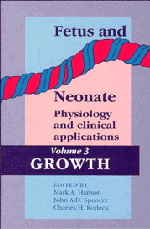Book contents
- Frontmatter
- Contents
- Preface to the series
- List of contributors
- Part I Physiology
- Part II Pathophysiology
- 6 Experimental restriction of fetal growth
- 7 Placental changes in fetal growth retardation
- 8 Human fetal blood gases, glucose, lactate and amino acids in IUGR
- 9 Glucose and fetal growth derangement
- 10 Fetal programming of human disease
- Part III Clinical applications
- Index
8 - Human fetal blood gases, glucose, lactate and amino acids in IUGR
from Part II - Pathophysiology
Published online by Cambridge University Press: 04 August 2010
- Frontmatter
- Contents
- Preface to the series
- List of contributors
- Part I Physiology
- Part II Pathophysiology
- 6 Experimental restriction of fetal growth
- 7 Placental changes in fetal growth retardation
- 8 Human fetal blood gases, glucose, lactate and amino acids in IUGR
- 9 Glucose and fetal growth derangement
- 10 Fetal programming of human disease
- Part III Clinical applications
- Index
Summary
Introduction
Intrauterine growth retardation (IUGR) implies failure to achieve the genetic growth potential for fetal size, but is a definition that encompasses a heterogeneous group. It is an important cause of mortality and morbidity in the perinatal period (Haas, Balcazar & Caulfield, 1987; Villar et al., 1990) and is associated with diseases in adult life such as non-insulin-dependent diabetes, hypertension and stroke (Barker et al., 1989). Although as yet there is no effective intrauterine treatment, assessment and management is important and has improved in the last two to three decades as a result of the introduction of ultrasound imaging, Doppler technology and ultrasound guided needle aspiration of fetal blood (cordocentesis). The latter enables investigation to confirm or refute a suspected diagnosis such as chromosomal abnormality, but has also improved our understanding of the pathology of growth retardation. Before this technique, information concerning the human fetal intrauterine environment and growth came predominantly from studies of umbilical cord blood samples at delivery or during labour from the capillaries of the presenting part following cervical dilatation and rupture of membranes. However, both these approaches provide samples which may reflect acute changes associated with delivery and not a steady state.
In this chapter we will review the techniques of fetal blood sampling before labour and the data on blood gases, glucose, lactate and amino acids obtained by cordocentesis in IUGR. We will also briefly consider the implications of the results for clinical practice.
- Type
- Chapter
- Information
- Fetus and Neonate: Physiology and Clinical Applications , pp. 201 - 222Publisher: Cambridge University PressPrint publication year: 1995
- 2
- Cited by



